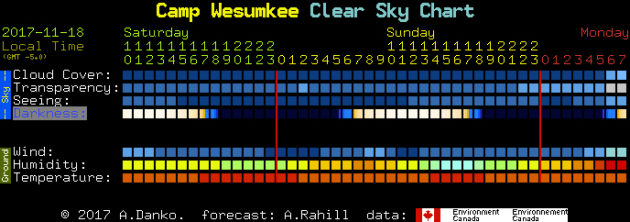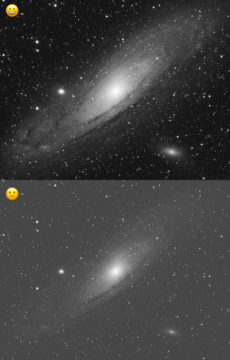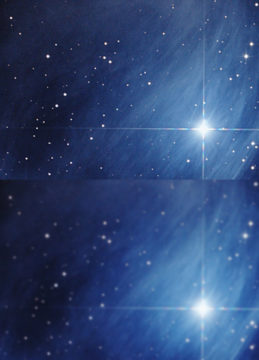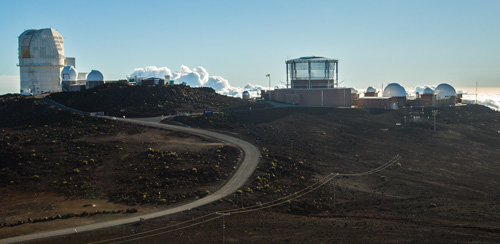Good weather for imaging is about more than just the clouds! Even if it's cloud-free, you'll need to understand if the seeing and transparency are good.
A couple of years ago, I attended the OkieTex star party: great location, great skies. I came about halfway through the week and upon arriving, I spotted a vendor friend.
“How’ve the skies been this week?” I asked. “Really good seeing, but the transparency has been not so great.” Cool, thanks.
A moment later I saw another acquaintance. “I hear the skies have been so-so, so far”, I said in greeting.
“Yeah”, he responded, “Really great transparency here, but the seeing last night after the storm was pretty bad.”
Hmmm…

One of these friends did not know the difference between seeing and transparency, and I now knew nothing of what to expect of the coming night. (Actually, I suspected the second friend had it right, and you will too by the end of this blog.)
I figure if there was some confusion between these two ideas among astronomy vendors, then it's likely widespread in the community at large. Indeed, my experience talking with people at star parties continues to bear this out. These two factors affect your imaging plan in two very different ways, so let’s take a look at what these two terms mean and how they affect your night and imaging strategy.

Richard S. Wright Jr.
First, let’s talk about transparency. Transparency is the opacity of the atmosphere, or how clear it is. Moisture and humidity lower the transparency, as does smoke or other kinds of pollution. It’s not entirely unlike light pollution in that it washes out the fainter details of astronomical targets. In fact, poor transparency typically makes light pollution worse because it scatters the light around instead of letting it escape into space away from your cameras and optics.
At my own dark sky camp, the city of Okeechobee to the south provides a transparency “meter,” if you will. How far the light dome extends into the sky isn’t just a factor of how many lights are burning, but how much moisture is in the air to scatter that light around.
When the transparency is poor, I select brighter objects and will shoot targets only when they are high in the sky, where there is as little pea soup to shoot through as possible. (As long as they're not in the direction of Okeechobee!)
Transparency usually gets better with altitude, because you're looking through less air. That's why high altitudes are prized for observatories and star parties.
Transparency is also usually very good after a rainstorm has come through to clear all of the particulates out of the air. This is reason number one I figured my second friend had it right at the star party.
Seeing, on the other hand, is a measure of atmospheric turbulence. We know that if we take a photo of a fast-moving subject, such as at a sporting event, with a low shutter speed, we'll get a blurry image. So what happens when you have to take a very long dark-sky photo and the stars are jumping all about due to atmospheric turbulence? That’s right, blurry stars and deep sky objects.
Seeing is usually measured in arcseconds, an angular measure that describes distance on the celestial sphere. If the seeing was 4 arcseconds, it means the stars can be expected to dance around inside a circle with a diameter of 4 arcseconds. Seeing of 1 arcsecond is 4 times better and would then yield much smaller, less bloated stars, as well as finer detail on deep sky objects.

Richard S. Wright Jr.
Seeing is typically better in places where the geography is very flat. The air masses moving over the land encounter few obstacles and flow more smoothly (sometimes called a laminar flow). This is one reason I love imaging in Florida in the wintertime: it has very good seeing. I have friends out West who moved to the desert to escape city lights, but now they're near mountains. The winds coming over the mountains gets all mixed up like a creek flowing over big boulders, which makes for terrible seeing.
Also, after a front comes through (often accompanied by some rainstorms), the air becomes turbulent for a day or so afterwards. Again, my second friend’s claim that after a storm the transparency was good and the seeing was poor fit this pattern best.
If mountains are good for transparency, but poor for seeing, why are so many observatories located up on big mountains? Because as they say... less is more. Less air at high altitudes yields better transparency as I've said, but at the highest mountains you are also above much of the turbulent air, which mitigates the effects on seeing.
Sometimes I will soldier through poor transparency, and if I take enough exposures and spend the time in post-processing, I can often pull something out that I’ll be proud of. Seeing, on the other hand, is often the real limiting factor. You can only do so much sharpening in post processing before things start to look ridiculous, and so if the images are just too soft, it’s time to go to bed, or start that Netflix marathon.

Richard S. Wright Jr..
Where to draw the line depends on your own personal tastes — and your image scale. Essentially, if your pixels are small and your focal length is long, the poor seeing will just make your images mushy. On the other hand, if you're using a very short focal length and larger pixels, you can do wide-field images of some bigger objects or constellations, with wild abandon to the seeing conditions. I'll return to the topic of pixel scale next month and talk more about how it relates to your seeing conditions.
 8
8









Comments
December 11, 2017 at 3:10 pm
From a photographic perspective "transparency" is equivalent to "contrast." "Seeing" is turbulence or subject movement ("wiggle") during exposure.
RWB
You must be logged in to post a comment.
Anthony Barreiro
December 11, 2017 at 6:33 pm
My understanding is that the tops of volcanic mountains on islands like Hawaii and Tenerife have very steady seeing because the smoothly sloping downhill terrain and the lack of any significant topography for great distances in any direction creates a very laminar wind flow. The air may be moving fast, but it is all moving at the same speed and in the same direction, without any eddies or other turbulence.
You must be logged in to post a comment.
December 13, 2017 at 12:07 pm
Anthony,
You are absolutely right too! Like in Florida, that smooth flow is fantastic and dramatically lowers the seeing threshold. The islands are about the best you can do with that plus the combined effects of elevation. In other parts of the world, there is also smooth terrain, but the proximity to the mountains ruins the seeing... however, ON the mountain is the win.
The nice thing too about volcanic mountains in the middle of the ocean (or anywhere) is they are single peaks, and not a whole chain of mountains, so they don't do much damage either in the first place.
Richard
You must be logged in to post a comment.
rar
April 10, 2018 at 5:35 pm
Thanks, great explanation! As someone getting into this, there is a lot of information out there about what different variables affect star gazing at night. My friends and I went out to try to see the stars a while ago when the cloud cover was good, even still we weren't able to get as good a view as we expected.
After doing some more research and coming across this article, I'm confident now we didn't have very good transparency that night. The location we chose was reported to have good (low) light pollution levels but cloud cover and light pollution aren't the only factors it seems 🙂
You must be logged in to post a comment.
Martian-Bachelor
May 31, 2018 at 11:58 am
This is an instance where the term "seeing" has both a colloquial and a technical meaning.
A polite thing to ask an astronomer just back from an observing run is "How was the seeing?". The answer is likely to encompass both the technical seeing and the transparency into one parameter, perhaps weighted twice as much on the former.
> If the seeing was 4 arcseconds, it means the stars can be expected to dance around inside
> a circle with a diameter of 4 arcseconds.
Or they don't dance around so much but instead "blow up" into large blobs when pockets of bad air move by overhead, before settling back down to something smaller. I've seen both kinds of seeing when guiding long exposures manually.
You must be logged in to post a comment.
Kevin Hanley
March 17, 2019 at 6:02 pm
So, transparency is about how many photons get through the atmosphere, while seeing is how much the atmosphere shakes 'em up (disturbs their otherwise ~parallel paths).
You must be logged in to post a comment.
Richard S. Wright Jr.Post Author
March 18, 2019 at 1:03 am
Kevin, Yep. Pretty much you nailed it.
You must be logged in to post a comment.
madrobin
October 13, 2019 at 11:41 am
Hi Richard,
I have started reading your astro photography blog and it's really well written so that in man with an ounce of brain like myself can easily understand it. THANK YOU. I will enjoy the rest of it this evening if I can understand all of it.
You must be logged in to post a comment.
You must be logged in to post a comment.